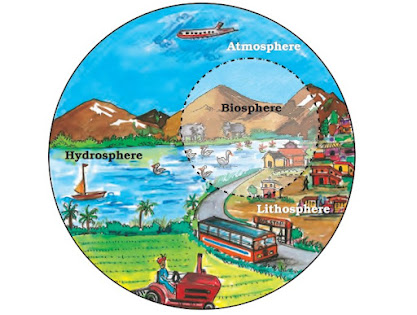Weather and Climate
Weather is this hour-to-hour,
day to day condition of the atmosphere. A hot or humid
weather may make one irritable. A pleasant, breezy
weather may make one cheerful and even plan for an
outing. Weather can change dramatically from day to
day. However, the average weather condition of a place
for a longer period of time represents the climate of a
place.
Temperature
The degree of hotness
and coldness of the air is known
as temperature.
The temperature of the
atmosphere changes not only
between day and night but also
from season to season. Summers
are hotter than winters.
An important factor that
influences the distribution of
temperature is insolation.
Insolation is the incoming solar
energy intercepted by the earth.
The amount of insolation
decreases from the equator
towards the poles. Therefore, the temperature decreases in the same manner. If
the earth’s temperature rises too high, it would become
too warm for some crops to grow. Temperature in cities
is much higher than that of villages. The concrete and
metals in buildings and the asphalt of roads get
heated up during the day. This heat is released during
the night.
Also, the crowded high rise buildings of the cities
trap the warm air and thus raise the temperature of
the cities.
Air Pressure
Air pressure is defined as the pressure exerted by the
weight of air on the earth’s surface. As we go up the
layers of atmosphere, the pressure falls rapidly. The air
pressure is highest at sea level and decreases with height.
Horizontally the distribution of air pressure is influenced
by temperature of air at a given place. In areas where
temperature is high the air gets heated and rises. This
creates a low-pressure area. Low pressure is associated
with cloudy skies and wet weather.
In areas having lower temperature, the air is cold. It
is therefore heavy. Heavy air sinks and creates a high
pressure area. High pressure is associated with clear and
sunny skies.
The air always moves from high pressure areas to low
pressure areas.
Wind
The movement of air from high pressure area to low
pressure areas is called wind. You can see wind at work
as it blows dry leaves down the pavement or uproots
trees during a storm. Sometimes when the wind blows
gently you can even see it blowing away smoke or fine
dust. At times wind can be so strong that it is difficult
to walk against it. You must have experienced it is not
easy to hold an umbrella on a windy day. Winds can be
broadly divided into three types.
- Permanent winds – The trade winds, westerlies and easterlies are the permanent winds. These blow constantly throughout the year in a particular direction.
- Seasonal winds – These winds change their direction in different seasons. For example monsoons in India.
- Local winds – These blow only during a particular period of the day or year in a small area. For example, land and sea breeze. Do you recall the hot and dry local wind of northern planes of India? It is called loo.
Moisture
When water evaporates from land and different
water bodies, it becomes water vapor. Moisture
in the air at any time, is known as humidity.
When the air is full of water vapor we call it a
humid day. As the air gets warmer, its capacity
to hold the water vapor increases and so it
becomes more and more humid. On a humid
day, clothes take longer to dry and sweat from
our body does not evaporate easily, making us
feel very uncomfortable.
When the water vapor rises, it starts cooling.
The water vapor condenses causing formation
of droplets of water. Clouds are just masses of
such water droplets. When these droplets of water
become too heavy to float in air, then they come
down as precipitation.
Jet planes flying in the sky leave a white trail
behind them. The moisture from their engines
condenses. We see trails of this condensed
moisture for some time when there is no air
movement to disturb it. Precipitation that comes down to the earth
in liquid form is called rain. Most of the ground
water comes from rainwater. Plants help preserve
water. When trees on hill sides are cut, rainwater
flows down the bare mountains and can cause
flooding of low lying areas.
Rainfall is very important for the survival of plants and
animals. It brings fresh water to the earth’s surface. If
rainfall is less – water scarcity and drought occur. On the
other hand if it is more, floods take place.



Comments
Post a Comment